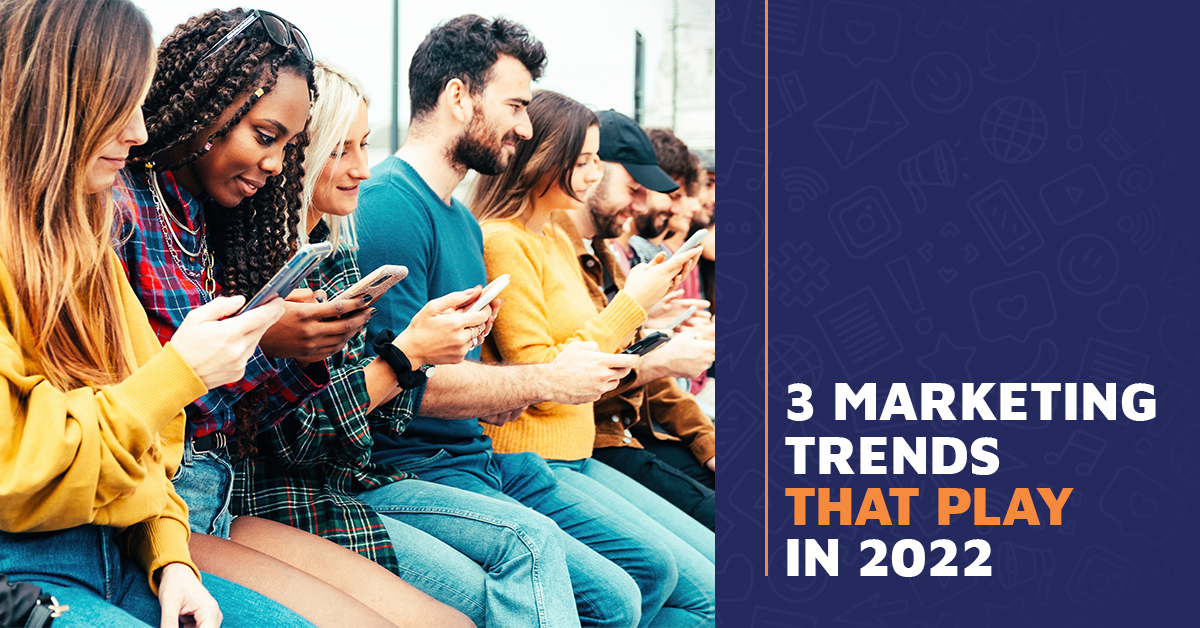3 Marketing Trends That Play in 2022

Being trendy is a fine line. On one hand, there is such a thing as trying too hard. It's kind of like when parents try to use slang when talking to their kids. It just doesn't work, no matter how "swaggy" you feel doing it (that felt gross just typing). On the other hand, if you can master certain trends, you can become relatable to everyone you're talking to.
When it comes to marketing, it’s essential to follow trends because the industry and how we communicate with each other is constantly changing. Here are a few recent marketing trends that you can seamlessly implement into your marketing strategy. And remember, keep current, stay flexible, and be real. Because the second you stop being relatable is the second you'll lose your audience.
1. Keep Video Content Short
While long-form videos still have a place in marketing where more depth and information are required, short videos have dominated in 2022. Whether it's marketing a product, brand, or service, marketers in the business-to-business (B2B) and business-to-consumer (B2C) space are learning that getting to the point quickly is more important than ever.
"But if I invest more time and resources into a long-form video, wouldn't that yield better results?"
Not necessarily. More bandwidth doesn't mean more effective. So not only do short videos require less bandwidth, but they also align perfectly with the fast-paced attention spans of online audiences who are very selective about what they engage with.
Remember that whole spiel we gave about not trying too hard to be trendy? Keep that in mind when we tell you about how platforms like TikTok are perfect places to host short video content. Being effective on TikTok is all about following the trends and even starting new ones. So, take risks but be intentional.
2. Permanent Social Media
Let's be clear: ephemeral content (content that disappears 24 hours after being published) isn't going anywhere. OK, it disappears, so I guess it is literally going away. But you get it. Marketers are discovering that permanent social media is still king. Having standard posts and videos seems to be more valuable for the bottom line and generating a solid return on investment.
However, this doesn't mean that you should abandon ephemeral social media. The combination of permanent and ephemeral social media can be the best of both worlds. With ephemeral content, you get the urgency and engagement of temporary posts. You get the long-term brand awareness and discoverability of content that doesn't disappear with permanent content.
The biggest takeaway is to weigh the pros and cons of which social platforms to use. You wouldn't use Snapchat or Instagram stories if you're interested in steady engagement and long-term results. So, think of your audience and select your platforms accordingly.
3. Testing Native Ads
As of last year, only about a quarter of global marketers said they utilized native advertising. But since then, data has shown that native advertising works, and interest has increased.
What exactly is native advertising? It's when you pay to feature content on a third-party site. However, whereas traditional advertising sticks out like a sore thumb on a platform, native ads blend right in with the platform, which is why they work.
Consumers are way more likely to interact with an ad that looks like it belongs on the page than something that looks, well, like an ad.
Because of its Shop and Story features, Instagram is probably the most popular social media network that regularly partners with brands for native ads. These advertisements are designed to look similar to a typical post from someone you follow.
CAUTION – You'll want to state clearly that your post is an ad. Viewers won't appreciate it if they think you're trying to trick them into engaging with your ad, so it's best to be transparent in a subtle way.
Start Joining the Trends
Now that you know the marketing trends that have taken over 2022, it’s time to implement them into your strategy. But be careful because the point of trends is that they come and go. So, the most important thing to remember is to stay flexible and continuously improve your strategy to account for changes in how we communicate. Good luck!
Our Recent Posts
Search
Explore our suite of services and how they can enhance your business. Contact us today to learn more!
